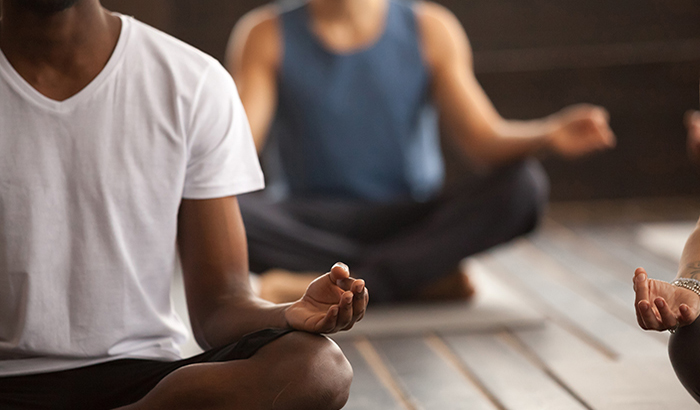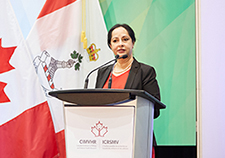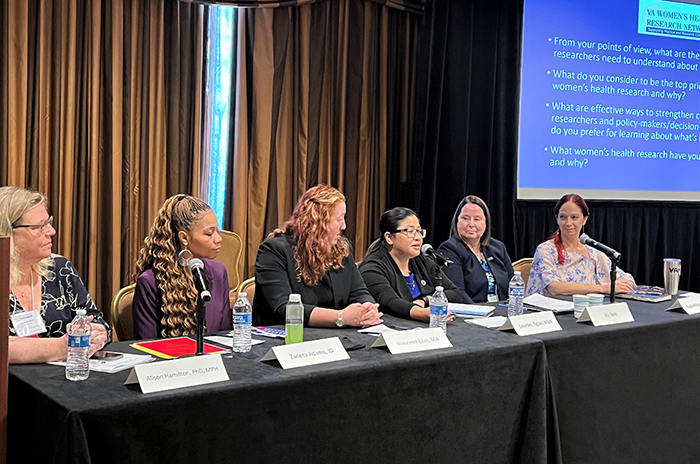Office of Research & Development |
 |


Dr. Barbara Niles, a research psychologist with VA's National Center for PTSD, led a review study on mind-body therapies for PTSD. (Photo: ©iStock/fizkes)
January 16, 2019
By Mike Richman
VA Research Communications
In VA, up to a quarter of Veterans seeking medical treatment since returning from the conflicts in Iraq and Afghanistan suffer from PTSD.
More than 80 percent of specialized VA programs to treat PTSD offer some form of mind-body therapy. Examples include yoga; relaxation; tai chi, an ancient Chinese form of self-defense; guided imagery, the use of words and music to evoke positive imaginary scenarios that improve mood or physical well-being; and mindfulness, in which one maintains an awareness of his or her thoughts, feelings, bodily sensations, and surrounding environment through a gentle, nurturing approach, with a focus on proper breathing.
How effective are these therapies in helping Veterans with PTSD, which can trigger flashbacks, nightmares, depression, hostility, and self-destructive behavior?
VA researchers reviewing nearly two dozen randomized VA trials on mind-body therapies gave three of the therapies a nod of approval. They concluded that although many papers on the topic are limited by weaknesses in the methodology, “recent studies have increased rigor”—the degree to which studies are carried out in a scientific way, with appropriate controls and a lack of biases. “On the whole, “the results for mindfulness, yoga, and relaxation are promising.”
The review appeared in the Journal of Clinical Psychology in September 2018.
"Veterans seem to really like mind-body treatments, which have very few negative side effects."
Dr. Barbara Niles, a research psychologist in the National Center for PTSD at the VA Boston Healthcare System, led the review. Her research focuses on the use of mind-body therapies for traumatized people.
“Veterans seem to really like mind-body treatments, which have very few negative side effects,” says Niles, who is also an assistant professor of psychiatry at Boston University. “It’s good that VA is moving forward to adopt these practices quickly. But we feel it’s also important to evaluate whether these programs are helping to reduce symptoms and improve quality of life and, if so, which mind-body programs are most helpful.”
VA, she notes, is “far ahead” of other health care systems in promoting mind-body treatments.
“Mind-body therapies will be used more and more in VA and will become part of regular clinical procedure, both as stand-alone treatments and in combination with other standard treatments,” she says. “Mind-body treatments may turn out to be very helpful in complementing trauma-focused psychotherapies, such as cognitive processing therapy [CPT] and prolonged exposure [PE].”
CPT and PE are the two main trauma-focused psychotherapies in VA. They’ve helped many Vets with PTSD overcome troubling experiences. CPT teaches people to evaluate upsetting thoughts that have existed since the trauma, with a focus on changing the way they look at themselves and the world. PE calls for patients talk about and confront the traumatic events they’ve been through—while they’re in a supportive environment—to help them realize that those memories are not harmful and to help subdue emotions like fear, anger, and sadness.

VA Researcher Named One of U.S.’ Top Female Scientists

Million Veteran Program director speaks at international forum

2023 VA Women's Health Research Conference

Self-harm is underrecognized in Gulf War Veterans
Niles’ review indicates that future research on the effectiveness of mind-body therapies alone and in combination with CPT and PE may lead to more situations that involve matching the right treatment to each individual patient.
“For example, mind–body treatments that focus on deep breathing and relaxation may work better for people with particularly high arousal symptoms,” the researchers write, “whereas psychotherapies may be optimal for those with greater elevations of [both] negative mood and [thought process].”
Currently, VA endorses eight mind-body therapies: acupuncture; meditation; yoga; biofeedback, a method of learning to control bodily functions by monitoring one’s own brain waves, blood pressure, and muscle tension; clinical hypnosis, which is similar in concept to mindfulness; guided imagery; massage; and tai chi and qi gong, another ancient Chinese form of self-defense. Qi gong involves movements that are repeated over and over, stretching the body, increasing fluid movement, and building awareness of how the body moves through space.
The therapies are most often used to help Veterans experiencing pain, primarily back aches and arthritis. The American College of Physicians recommends non-drug therapies, such as tai chi, yoga, relaxation, and mindfulness-based stress reduction, for treating low back pain.
For their review, Niles and her colleagues evaluated 22 completed trials. To meet the criteria, the trials needed a random assignment of Veterans to groups; valid quantitative outcome measurements; the reporting of dropout rates; appropriate statistical methods; and conclusions supported by findings, among other standards. Also, the study participants needed a minimum level of PTSD symptoms or a diagnosis of PTSD.
Of the 22 articles, which included Veterans and non-Veterans, nine on mindfulness, six on yoga, and seven on relaxation met the inclusion criteria.Mindfulness means maintaining a moment-by-moment awareness of our thoughts, feelings, bodily sensations, and surrounding environment, through a gentle, nurturing lens. Mindfulness means maintaining a moment-by-moment awareness of our thoughts, feelings, bodily sensations, and surrounding environment, through a gentle, nurturing lens.No trials examining tai chi or qi gong made the cut.
Mindfulness—The nine mindfulness studies differed substantially in terms of methodology. Seven of the nine included mainly male Veterans; the other two examined mainly female participants. Seven of the studies also showed reductions in PTSD symptoms from pre- to post-treatment when compared with the control groups. The “within-group effect sizes, when reported, were uniformly large, suggesting that mindfulness can have a considerable impact” on people with PTSD symptoms.
Dropouts during treatment were less than 25 percent for most of the studies. “In general,” the researchers write, “mindfulness interventions are accessible and feasible, associated with reductions in PTSD symptoms, and can be delivered individually, in a group, through a telehealth format, in a primary care setting, or at a mental health clinic.”
Yoga—In all six studies, researchers used a form of yoga that is practiced with a sensitivity to PTSD symptoms (see sidebar). For example, patients are invited, not instructed, to adopt yoga poses, and instructors do not touch patients.
Four of the six studies found positive effects ranging from moderate to large in a treatment group when it was compared to a control group. Two of the studies reported that treatment gains were maintained over the one- to six-month follow-up period. “Taken together, these [six] studies indicate that yoga is an acceptable and feasible intervention that may be associated with PTSD symptom reductions,” Niles and her team write.
The researchers note that one study gave important preliminary support for yoga as an effective treatment for PTSD, although there were no follow-up assessments to test the lasting effects of the improvements. The study included 64 women with chronic, treatment-resistant PTSD who were randomly assigned to a yoga group or a supportive women’s health education group.
In addition, a small study found “significant and lasting” benefits in Sudarshan Kriya yoga, a breathing-based meditation. Post-9-11 Veterans took part in group sessions lasting three hours a day for seven days. They experienced a major drop in PTSD symptoms, with the strongest effect on hyperarousal and reexperiencing symptoms, such as intrusive memories, upsetting dreams, flashbacks, and distress from reminders of the trauma. The reductions were maintained at one month and one-year follow-up.
According to the researchers, yoga as a whole significantly reduced PTSD symptoms, with a positive impact comparable to that of psychotherapeutic and psychopharmacologic approaches. “Yoga may improve the functioning of traumatized people by helping them tolerate physical and sensory experiences associated with fear and helplessness and to increase emotional awareness and affect tolerance,” Niles and her colleagues write.
Relaxation—Relaxation is based on reducing stress levels in body muscles and focuses on proper breathing and thoughts of pleasant images. In the seven relaxation studies, researchers examined the technique as a control comparison to trauma-focused psychotherapies, including cognitive processing therapy and prolonged exposure.
Because relaxation was used only as a control therapy, the seven studies in general provided limited detail about the types of relaxation and the benefits that were derived. But researchers in four of the studies found large reductions in PTSD symptoms at the end of the relaxation group, indicating that the relaxation treatment benefited those with PTSD symptoms. The other three studies didn’t report the levels of effects but did note reduced PTSD severity with all treatment conditions, including relaxation.
In Niles’ review, the researchers found a mixture in overall study methodology regarding length (20 to 90 minutes), frequency of the sessions (daily to weekly), and the length of the program (2 to 15 weeks).
Niles and her team also offered suggestions on the design of future mind-body trials, including the development of treatment manuals with detailed descriptions and audio or video recordings of elements of the therapies.
Although the review found no high-quality studies looking at tai chi for PTSD, Niles isn’t dismissing that exercise as a therapy for the mental health condition. Tai chi has developed into a graceful exercise that is known to improve balance and coordination and decrease pain.
In 2016, Niles led a feasibility study on tai chi that included 17 Veterans who had reported major PTSD symptoms. More than 90 percent said they were satisfied with the program and many of the participants indicated that the tai chi sessions helped in managing their symptoms, such as intrusive thoughts and concentration difficulties, and in improving attention, alertness, and information processing.
She’s now leading a randomized trial to test the effectiveness of tai chi in the context of Gulf War illness.
“Given the interest in tai chi and other mind-body treatments,” she says, “and the rigorous studies that show that tai chi is helpful for other ailments, there’s need for good research on tai chi for PTSD. We think tai chi will be very helpful to Veterans and will address both the psychological and physical consequences of the disorder. Many Veterans have done some martial arts training in the past. So they may be drawn to tai chi because it is a martial art.”
Dr. Benjamin Kligler is the national director of VA’s Integrative Health Coordinating Center, which is part of the Office of Patient Centered Care and Cultural Transformation. He’s excited about the future of mind-body therapies in VA, noting that they’ll never replace psychotherapies, which he calls the “cornerstone of PTSD treatments and treatments for all mental health conditions,” but can certainly complement them.
“There’s developing evidence for the use of mind-body therapies,” he says. “They have huge potential and tons of interest from Veterans and clinicians. They give the clinician and the Veteran more tools and options as to how to make the work of the psychotherapy more effective.”
Kligler’s office is responsible for promoting the concept of patient-centered care, which has come to mean helping people develop the skills and tools to take better care of themselves.
“These mind-body therapies are really in that category,” he says. “It’s a natural fit for us to be part of trying to make them available to Veterans because part of the big picture of whole health and patient-centered care is empowering the Veteran, empowering the patient. These skills are really part of what people can do for themselves. Also, the evidence base for these therapies has grown over the last five years to where many of them are now part of mainstream guidelines for chronic pain.”
Chris Quail served for 12 years in the U.S. Army, a period that included two overseas tours and duty at four stateside bases.
Since stepping down from the military in 1992, he’s been diagnosed with a case of PTSD that he says is related to him being a victim of military sexual trauma. He’s experienced depression, nightmares, scary daytime thoughts, insomnia, anger and rage, a lack of trust in people, extreme weight gain and loss, a sense of being held down, and chronic pain.
In recent months, Quail has been in a multi-pronged therapeutic program at the VA St. Louis Health Care System. He participates with a psychologist in a trauma-focused psychotherapy, prolonged exposure, takes medication, and attends a trauma-based yoga class (see main story). He also works with a whole-health coach to target specific well-being goals, such as weight control and proper nutrition.
Everything he’s doing to alleviate his PTSD symptoms has helped with his depression, anxiety, anger, and physical issues, he says. He thought the yoga class, in particular, was “hokey” when it began, believing it wouldn’t help in any way. But the meditation-heavy exercise has since eased his feelings of pain, grief, and suffering. It has also provided a feeling of being “whole again instead of broken,” as he put it.
The hour-long class is for Veterans with PTSD and includes a small number of participants—anywhere from four to eight—to allow for ample one-on-one attention. “I wouldn’t want to be in a class with 20 people,” he says.
“What’s great is it’s not military style,” he says. “It’s not like dress right dress, formations, pushups, do this, do that. We’ll pick a topic like breathing and focus on whatever concerns you’re hanging onto during that session. In every movement that you’re making, like a warrior pose, you’re specifically focusing on releasing whatever it is that you’re dealing with.
“When you have PTSD, you don’t realize that you’re not flexible,” he adds. “You get so rolled up into a ball of yarn that you don’t realize the stress and tension and everything that you’re carrying. The yoga has improved my flexibility and ability to move. I’ve felt stuck at times because of the trauma, and the yoga has helped me feel empowered to move my body and to realize that I have control over myself. All of your symptoms are connected in some way, so your mental trauma is affecting your body physically.”
Quail notes that the yoga has complemented his prolonged exposure (PE) therapy by reducing his anxiety, making him calm, and improving his ability to breath. With PE, patients talk about and confront the traumatic events they’ve been through—while they’re in a supportive environment—to help them realize that those memories are not harmful and to help subdue emotions like fear, anger, and sadness. Case in point: Being in a crowded area where you can’t see people behind you may bring up anxious feelings, but it doesn’t mean something bad will happen.
According to Dr. Benjamin Kligler, national director of VA’s Integrative Health Coordinating Center, Quail’s account of how a mind-body therapy like yoga can support a psychotherapy is far from unique.
“We hear that story from Veterans over and over and over,” Kligler says. “The truth is PTSD is hard to treat. Treatments like prolonged exposure work well. But some people need to pick up other skills to be able to work with PE therapy.”
Quail also receives acupuncture for his chronic shoulder and back pain, noting that it has made it easier for him to sleep at night.
“The acupuncture helps with anxiety and rest,” he says. “I hadn’t slept through the night in 30 years because I would always wake up every single night repeating the trauma. I would repeat the trauma in my mind during the day, too. I actually slept seven hours after my first treatment three weeks ago. It was the first time I had slept seven hours in 30 years.”
As Quail see it, his rehab program has changed his life and “taken me off the possible list of 20.” He’s referring to the average of 20.6 Veterans and service members who die by suicide every day. He explains that he used to have trust and security concerns and put sheets over the windows in his house. He recently took them down. But he admits that without his whole health coach “helping me navigate the plethora of information and healing opportunities, as well as my psychologist,” he’d still be on the couch with a gun within reach and his window covered.
The Army Vet hopes that getting the word out on the myriad treatment options that are available to Veterans with PTSD will help stop them from killing themselves.
“Everyone I talk to about it, every Veteran that I see, has been trained to suck it up,” says Quail, his voice cracking with emotion. “We have to realize that we don’t have to suck it up. Twenty people kill themselves every day because they suck it up. They don’t get help. If I can help just one person get off that list a day, then I want to help, too.”
--- Mike Richman
VA Research Currents archives || Sign up for VA Research updates